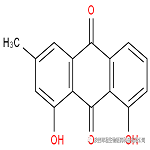Rhubarb is a collective name for various perennial plants of the Polygonaceae Rhubarb genus, and it is also the name of Chinese medicinal materials. In Chinese literature, "rhubarb" often refers to horseshoe rhubarb. In China, rhubarb is mainly used for medicinal purposes, but in Europe and the Middle East, their rhubarb often refers to several other species of rhubarb used for food. The stems are red, fragrant, bitter and slightly astringent, sticky to the teeth, and have a gritty feel. . The stems and leaves are withered in late autumn or excavated before germination in the next spring. Remove fine roots, scrape off the outer skin, cut flaps or segments, string them into strings and dry or directly dry. The traditional Chinese medicine rhubarb has the functions of attacking stagnation, clearing damp and heat, purging fire, cooling blood, removing blood stasis, and detoxifying.
Rhubarb has a variety of active ingredients, among which anthraquinones, dianthrones, stilbenes, tannins and polysaccharides are the most studied; their pharmacological effects mainly include regulating gastrointestinal function, anti-pathogenic microorganisms, anti-tumor, and protecting cardiovascular and cerebrovascular , anti-inflammatory, liver protection and anti-aging. In recent years, a lot of research has been done on rhubarb at home and abroad. Its pharmacological effects have been continuously recognized, and the scope of clinical application has gradually expanded. Coupled with people's continuous recognition of traditional Chinese medicine, the clinical use of rhubarb has increased year by year, and the price of medicinal materials has also risen.
Shaanxi Cuicheng Company focuses on the discovery and application of natural small molecule drugs and the development and industrialization of drug enzyme-catalyzed green synthesis technology. At present, our company has 15 active ingredients of rhubarb series - rhein-8-O-glucoside, emodin methyl ether-8-O-β-D-glucoside, aloe-emodin-3-(hydroxymethyl)- O-β-D-glucoside, chrysophanol-1-O-β-D-glucoside, aloe-emodin-8-O-β-D-glucoside, aloe-emodin, rhizomatin, emodin methyl ether -1-O-β-D-glucoside, chrysophanol-8-O-β-D-glucoside, emodin-8-O-β-D-glucoside, emodin, rhein, emodin Methyl ether, emodin, chrysophanol and other products, the information is as follows:
 Chrysophanic acid CAS:481-74-3 Molecular formula:C15H10O4 Purity:98%(HPLC) | Emodin CAS:518-82-1 Molecular formula:C15H10O5 Purity:98%(HPLC) | Physcion CAS:521-61-9 Molecular formula:C16H12O5 Purity:98%(HPLC) |
Rhein CAS:478-43-3 Molecular formula:C15H8O6 Purity:98%(HPLC) |
Rhapontigenin CAS:500-65-2 Molecular formula:C15H14O4 Purity:98%(HPLC) |
Emodin-8-glucoside CAS:23313-21-5 Molecular formula:C21H20O10 Purity:98%(HPLC) |
Chrysophal 8-O-glucoside CAS:13241-28-6 Molecular formula:C21H20O9 Purity:98%(HPLC) |
Physcion 8-o-beta-D- monoglucoside CAS:26296-54-8 Molecular formula:C22H22O10 Purity:98%(HPLC) |
RHAPONTIN CAS:155-58-8 Molecular formula:C21H24O9 Purity:98%(HPLC) |
Aloe-eModin-8-O-β-D- glucopyranoside CAS:33037-46-6 Molecular formula:C21H20O10 Purity:98%(HPLC) |
Chrysophanein CAS:4839-60-5 Molecular formula:C21H20O9 Purity:98%(HPLC) |
Aloe-emodin-3-(hydroxymethyl) -O-β-D-glucopyranoside CAS:50488-89-6 Molecular formula:C21H20O10 Purity:98%(HPLC) |
Physcion 8-β-D-glucoside CAS:23451-01-6 Molecular formula:C22H22O10 Purity:98%(HPLC)
|
RHEIN-8-GLUCOSIDE CAS:34298-86-7 Molecular formula:C21H18O11 |
Contact: Emma Chen
Phone: +8618791163155
Tel: +8618791163155
Email: 18791163155@163.com
Add: Room 403,Building 8,West Life Science and Technology Park,Keyuan 4th Road,Xixian New District,Xi'an City,Shaanxi Province
We chat
